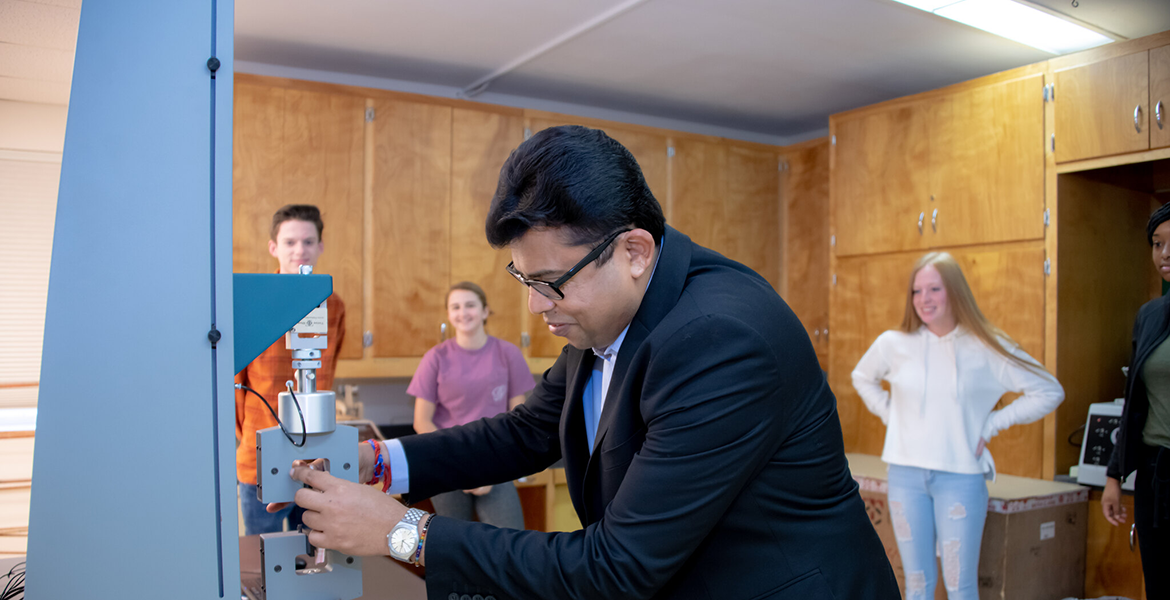
Clothing that saves lives
Thursday, January 14, 2021
Fashion isn’t only for the runway. For workers in the oil and gas industry, clothing can be a last defense from environmental hazards, avoiding injury and saving lives.
A research team led by Dr. Sumit Mandal, assistant professor in the Oklahoma State University Department of Design, Housing and Merchandising (DHM), is designing safer and more comfortable personal protective equipment (PPE) for oil and gas industry workers. Dr. Lynn Boorady, DHM department head, says Mandal’s work is part of a larger area of apparel design, functional fashion, emphasizing wearability and usability.
“Personal protective equipment is anything worn to prevent injury or to minimize hazards people face in their workplace,” Boorady said. “Researchers must understand the job requirements, the environmental conditions the job takes place in, how best to don/doff the equipment and what the limitations can or should be.”
PPE ranges from sports equipment and astronaut suits to safety gloves for welders and chemical protection suits. DHM research has tested PPE ranging from oven mitts to ballistic-proof military gear.
“PPE design is not about making the item attractive per se, though image is very important in some professions,” Boorady said. “PPE is about protecting the wearer from the hazards and conditions of their workplace while being able to move in order to conduct that work.”
Mandal’s research specifically considers how extreme outdoor conditions can affect the protective nature of oil and gas industry PPE. According to the Center for Public Integrity, from 2008 to 2017, 1,566 oil and gas drilling workers died from work-related injuries.
“Workplace hazards range from extreme outdoor heat to chemicals and heavy equipment,” Mandal said. “Our work can save lives, in addition to improving the comfort of PPE.”
Mandal’s grant from the Southwest Center for Occupational and Environmental Health and the University of Texas Health Science Center at Houston School of Public Health will support testing the materials used to make oil and gas industry PPE. Factors like breathability, tensile strength, flexibility and even colorfastness influence wearer experience.
“Traditional methods of testing fabric can be time-consuming and expensive,” Mandal said. “We plan to integrate numerous fabric characteristics into models to accelerate future PPE fabric evaluation.”
OSU is one of only a few undergraduate fashion programs offering courses in functional clothing design and similar topics such as anthropometrics, the science of studying dimensions of the human body, and ergonomics.
As students learn the unique requirements of functional fashion, Boorady believes they are better prepared to incorporate principles of clothing design and human ergonomics into all areas of fashion.
“I'm always amazed at where my students end up because functional fashion is such an important aspect of our lives,” Boorady said. “I’ve had students work for a leading diaper manufacturer to improve fit, and another even works for a circus developing elephant costumes. Right now, a student who rides motorcycles is studying ways to improve the comfort of safety gear.”
Boorady believes the real-life impacts of PPE research, underscores the importance of functional fashion.
“This is some of the most important work we do,” Boorady said. “This area takes people-focused research very seriously, as often people’s lives depend on our research and design capabilities.”
Related stories
- Clothing sizes of the future
- Designing fire-proof clothing with technology of the future
- OSU fashion design and fashion merchandising ranked top 20 in U.S.
MEDIA CONTACT: Brittany Bowman | 405-744-9347 | brittany.bowman@okstate.edu
